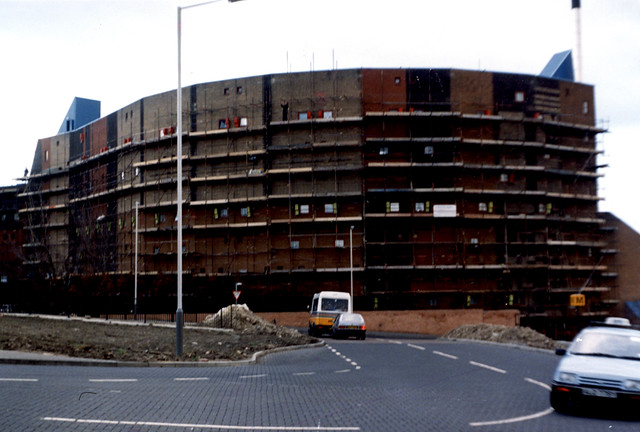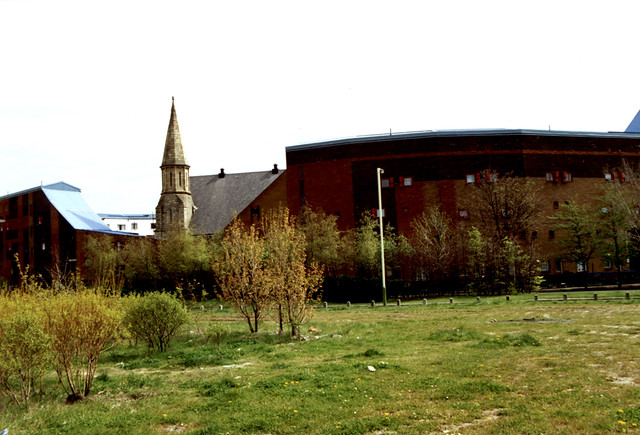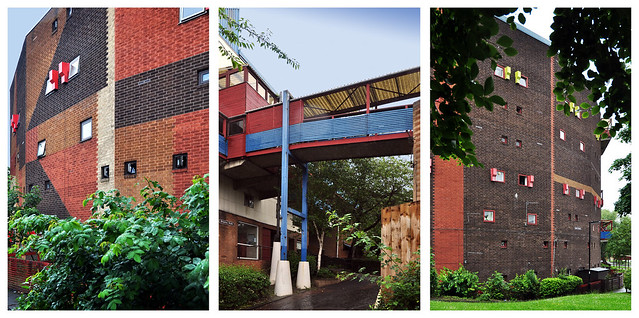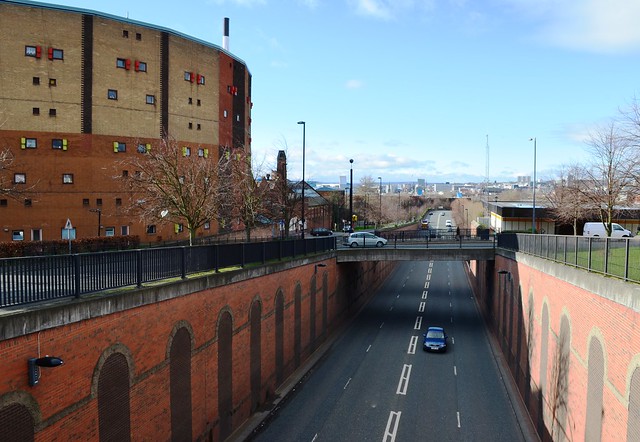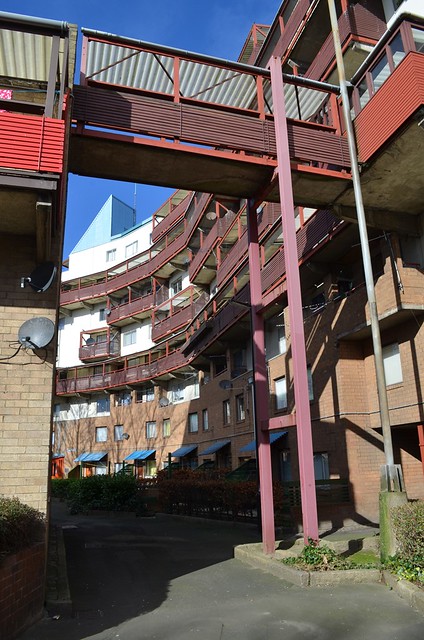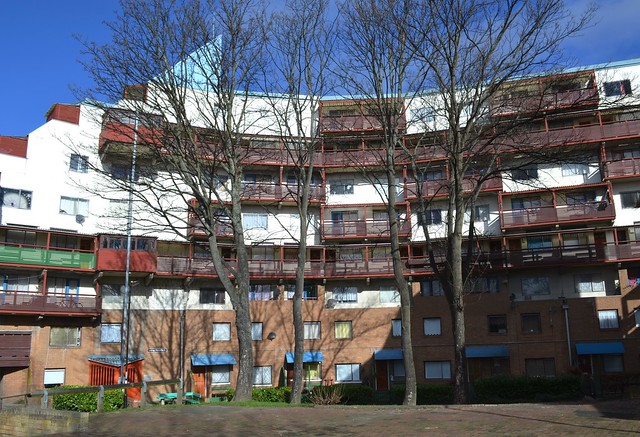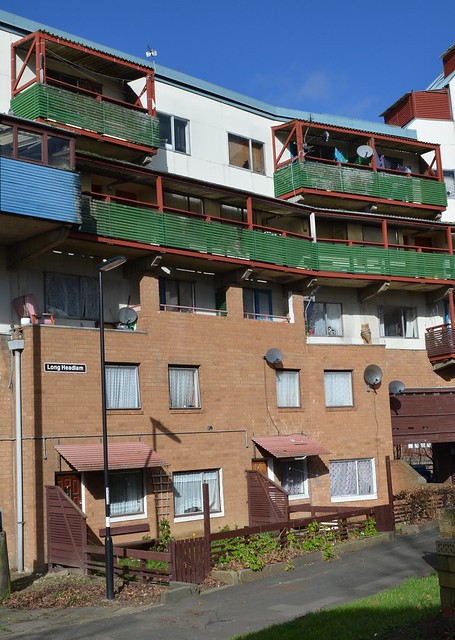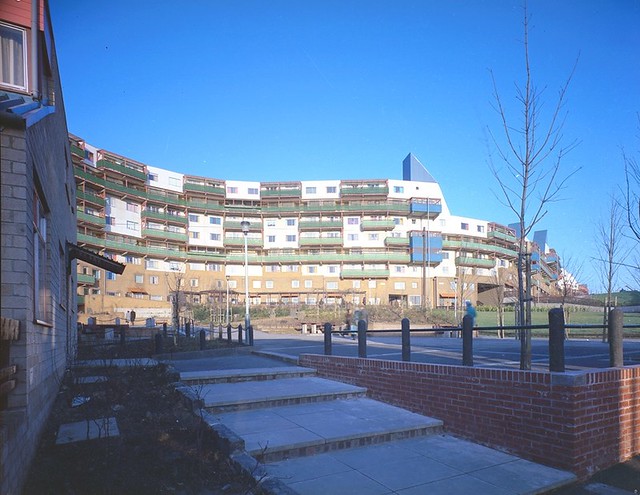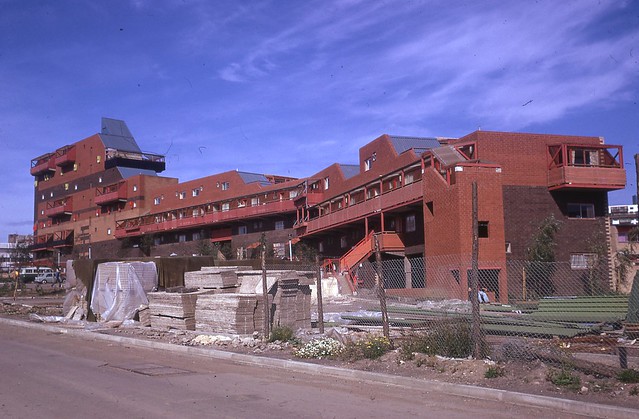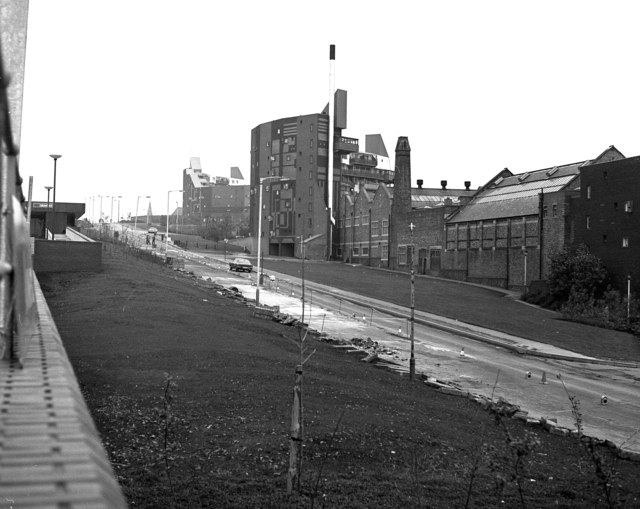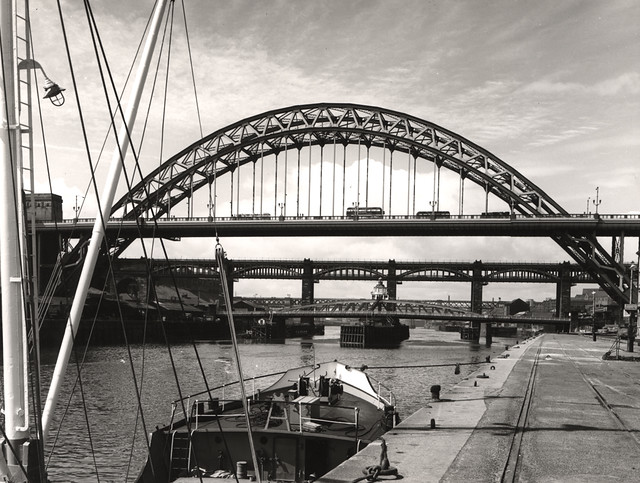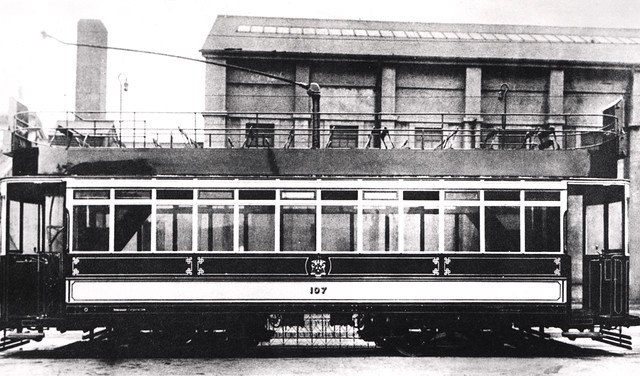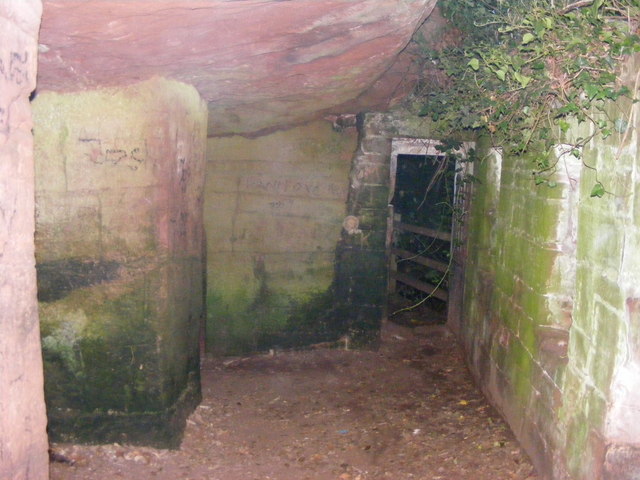Topics > Tyne and Wear > Newcastle upon Tyne > Byker > Byker Wall
Byker Wall
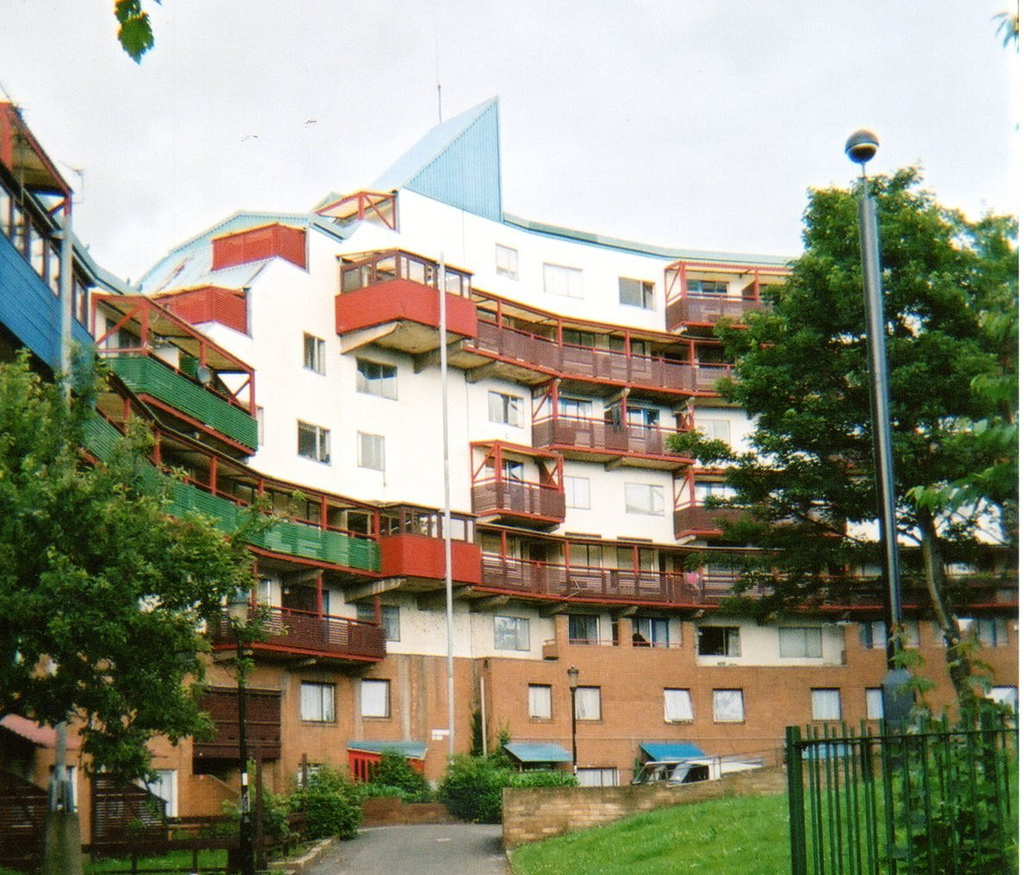 The Byker Wall is the centrepiece of the redevelopment of the Byker Estate designed by architect Ralph Erskine and built between 1969 and 1982. The Byker Estate is home to around 9,500 people. The redevelopment replaced existing Victorian terraced housing which was dilapidated and condemned. An aim of the redevelopment was to maintain the strong sense of community in Byker. A few key buildings from the old estate were incorporated into the new design, including pubs, churches and swimming baths. The layout was landscaped with trees and gardens with spaces to encourage social interaction, with the idea that cars should be left at the edges of the estate. The redevelopment has won international awards and became Grade II listed in January 2007. The Byker Community Trust was set up in 2011 and the housing stock was transferred to the Trust in 2012. In April 2014 a 2 year programme was undertaken including refurbishment of roofs, doors and windows - repainted in the same colour scheme of the original redevelopment.
The Byker Wall is the centrepiece of the redevelopment of the Byker Estate designed by architect Ralph Erskine and built between 1969 and 1982. The Byker Estate is home to around 9,500 people. The redevelopment replaced existing Victorian terraced housing which was dilapidated and condemned. An aim of the redevelopment was to maintain the strong sense of community in Byker. A few key buildings from the old estate were incorporated into the new design, including pubs, churches and swimming baths. The layout was landscaped with trees and gardens with spaces to encourage social interaction, with the idea that cars should be left at the edges of the estate. The redevelopment has won international awards and became Grade II listed in January 2007. The Byker Community Trust was set up in 2011 and the housing stock was transferred to the Trust in 2012. In April 2014 a 2 year programme was undertaken including refurbishment of roofs, doors and windows - repainted in the same colour scheme of the original redevelopment.
The Byker Wall is the name given to a long unbroken block of 620 maisonettes in the Byker district of Newcastle upon Tyne, England. They were designed by architect Ralph Erskine and constructed in the 1970s. The wall is just part of the estate which covers 200 acres.
Design and construction
The Wall, along with the low rise dwellings built to its south, replaced Victorian slum terraced housing. There were nearly 1200 houses on the site at Byker. They had been condemned as unfit for human habitation in 1953, but demolition did not begin until 1966.
The new housing block was designed by the notable architect Ralph Erskine assisted by executive architect Vernon Gracie. Design began in 1968 and construction took place between 1969 and 1982. The architects opened an office on site to develop communication and trust between the existing residents. Existing buildings were to be demolished as the new accommodation was built.
The new high-rise block was designed to shield the site from an intended motorway (which eventually was never built). Construction materials for Byker Wall were relatively cheap, concrete, brick and timber. Surfaces were treated with bright colours, while brick bandings were used on the 'Wall' to indicate floor levels.
Its Functionalist Romantic styling with textured, complex facades, colourful brick, wood and plastic panels, attention to context and relatively low-rise construction represented a major break with the Brutalist high-rise architectural orthodoxy of the time.
Following completion, less than 20% of the original local residents were housed at Byker Wall.
Refurbishment
Refurbishment of the whole estate was commenced in partnership with Your Homes Newcastle (YHN), the social housing arm of Newcastle City Council. The work was undertaken by Mansell, a division of Balfour Beatty. The work involved careful reinstatement of original features and colour schemes, using modernised materials where possible, while retaining the look and feel of the 1970s design scheme. For example, a new coloured aluminium window frame was designed to allow for improved security and insulation, without compromising the visual impact of the buildings. The most recent phase of this was completed in June 2008. A bid for PFI funding from the Homes and Communities Agency (to the value of £80 million) was sought in June 2009 to fund the project, which was estimated to cost £210 million, but was rejected as it did not meet the criteria; subsequent negotiations with the Department for Communities and Local Government led to the creation of the Byker Community Trust in 2012.
A two-year refubishment programme with a budget of £26 million began in April 2014. New roofs, doors and windows will be installed and the estate will be repainted in line with the original colour scheme.
Byker Community Trust
The Byker Community Trust (‘BCT’) was incorporated in September 2011 under the Industrial and Provident Society Act 1965 with charitable objectives. BCT is also a ‘registered provider’ of social housing.
In July 2012 a stock transfer from Newcastle City Council was completed and BCT became the owner of 1,800 properties. The creation of BCT has had the support of Newcastle City Council, the Homes and Communities Agency and English Heritage. The proposal for the stock transfer was also supported by the tenants of the estate who voted in favour of the transfer in a ballot in June/July 2011.
The government wrote off the historic debt associated with the Estate which enabled BCT to secure funding from the Yorkshire Building Society (a loan facility of up to £12m over the next 5 years).
The vision of BCT is ‘to secure for the Byker Estate high quality sustainable housing and services, where people want to live and work with a sense of pride in their homes and communities.
Awards and recognition
In 2013 Bolam Coyne won the Royal Institute Chartered Surveyors award for Best North East Regeneration Project of the Year.
In 2003 the UK Department for Culture, Media and Sport announced a proposal to award the Byker estate, of which the Wall forms a part, a Grade II listed rating as an example of outstanding architecture. In January 2007 the Estate became a grade II* listed building (grade two star).
Its innovative and visionary design has earned it many awards notably the Civic Trust Awards, the Eternit Award, the Ambrose Congreve Award for Housing (in 1980) and the Veronica Rudge Green Prize for Urban Design from Harvard University. The Wall has also been placed on UNESCO's list of outstanding twentieth century buildings.
In 1988 Byker Wall was featured in an episode of Building Sights presented by writer Beatrix Campbell, who compared the development to a pomegranate.
The Byker estate received a Grade II* heritage listing in 2007, citing its "groundbreaking design... influential across Europe" and its “pioneering... approach to public participation".
Notable residents
The Byker Wall was infamous as the home of "Ratboy" a juvenile delinquent who hid in its heating shafts when running from police during the 1990s.
Visit the page: Byker Wall for references and further details. You can contribute to this article on Wikipedia.
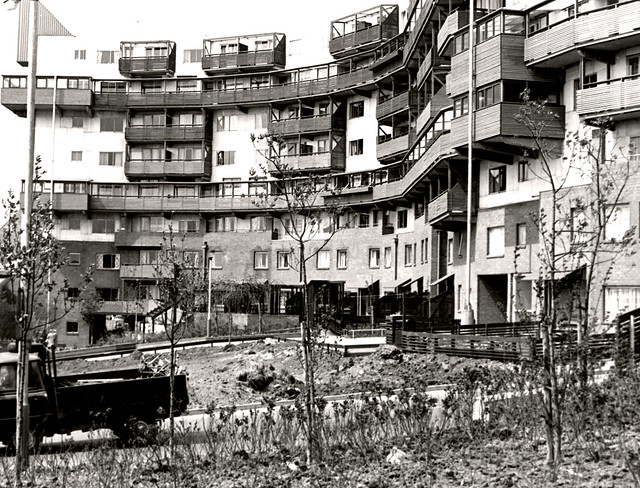
from Newcastle libraries (flickr)
022589:Byker Wall Byker City Engineers 1974
Pinned by Simon Cotterill
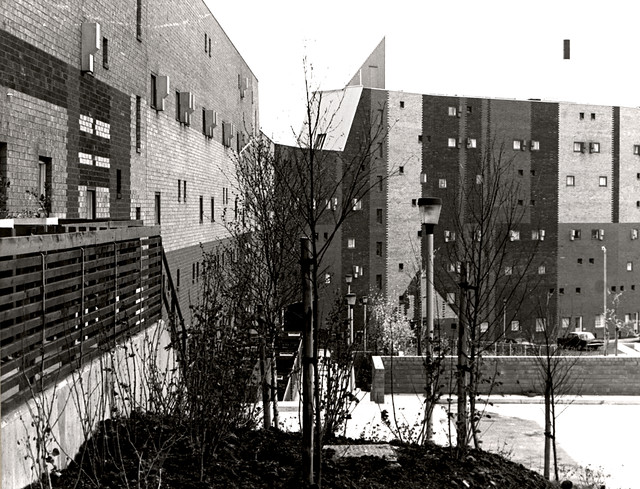
from Newcastle libraries (flickr)
022586:Byker Wall Byker City Engineers 1974
Pinned by Simon Cotterill
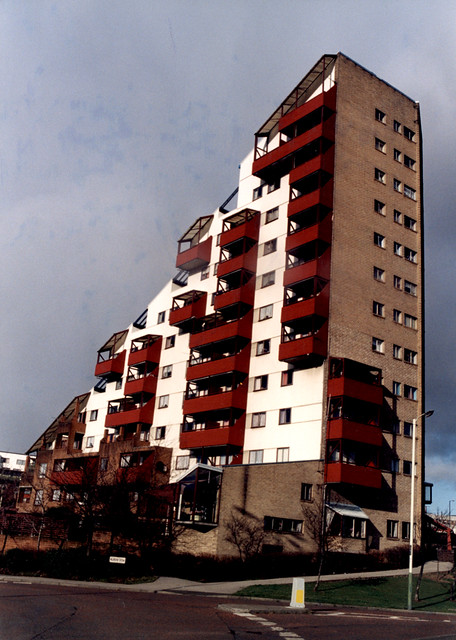
from Newcastle libraries (flickr)
067275:Byker Wall Byker Leighton David 1999
Pinned by Simon Cotterill

from Newcastle libraries (flickr)
028837:Byker Wall Byker City Engineers 1976
Pinned by Simon Cotterill

from Youtube (youtube)
Byker Drone Flight AMAZING HD! - Newcastle-Upon-Tyne - #EpicDroneClips No.5
Pinned by Simon Cotterill


from Newcastle libraries (flickr)
022589:Byker Wall Byker City Engineers 1974
Pinned by Simon Cotterill

from Newcastle libraries (flickr)
022586:Byker Wall Byker City Engineers 1974
Pinned by Simon Cotterill

from Newcastle libraries (flickr)
067275:Byker Wall Byker Leighton David 1999
Pinned by Simon Cotterill

from Newcastle libraries (flickr)
028837:Byker Wall Byker City Engineers 1976
Pinned by Simon Cotterill

from Youtube (youtube)
Byker Drone Flight AMAZING HD! - Newcastle-Upon-Tyne - #EpicDroneClips No.5
Pinned by Simon Cotterill
